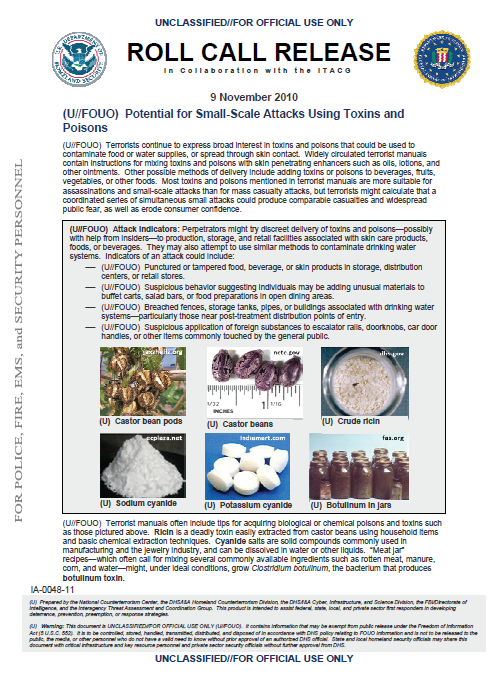DHS Roll Call Release
- 3 pages
- For Official Use Only
- November 9, 2010
(U//FOUO) Potential for Small-Scale Attacks Using Toxins and Poisons
(U//FOUO) Terrorists continue to express broad interest in toxins and poisons that could be used to contaminate food or water supplies, or spread through skin contact. Widely circulated terrorist manuals contain instructions for mixing toxins and poisons with skin penetrating enhancers such as oils, lotions, and other ointments. Other possible methods of delivery include adding toxins or poisons to beverages, fruits, vegetables, or other foods. Most toxins and poisons mentioned in terrorist manuals are more suitable for assassinations and small-scale attacks than for mass casualty attacks, but terrorists might calculate that a coordinated series of simultaneous small attacks could produce comparable casualties and widespread public fear, as well as erode consumer confidence.
(U//FOUO) Terrorist manuals often include tips for acquiring biological or chemical poisons and toxins such as those pictured above. Ricin is a deadly toxin easily extracted from castor beans using household items and basic chemical extraction techniques. Cyanide salts are solid compounds commonly used in manufacturing and the jewelry industry, and can be dissolved in water or other liquids. “Meat jar” recipes—which often call for mixing several commonly available ingredients such as rotten meat, manure, corn, and water—might, under ideal conditions, grow Clostridium botulinum, the bacterium that produces botulinum toxin.
(U//FOUO) Attack Indicators: Perpetrators might try discreet delivery of toxins and poisons—possibly with help from insiders—to production, storage, and retail facilities associated with skin care products, foods, or beverages. They may also attempt to use similar methods to contaminate drinking water systems. Indicators of an attack could include:
— (U//FOUO) Punctured or tampered food, beverage, or skin products in storage, distribution centers, or retail stores.
— (U//FOUO) Suspicious behavior suggesting individuals may be adding unusual materials to buffet carts, salad bars, or food preparations in open dining areas.
— (U//FOUO) Breached fences, storage tanks, pipes, or buildings associated with drinking water systems—particularly those near post-treatment distribution points of entry.
— (U//FOUO) Suspicious application of foreign substances to escalator rails, doorknobs, car door handles, or other items commonly touched by the general public.

